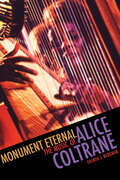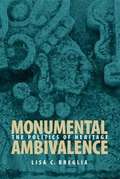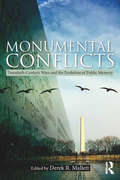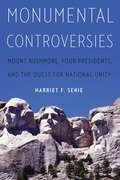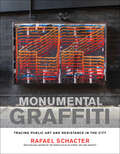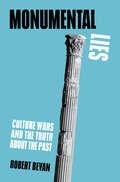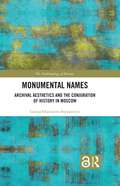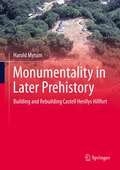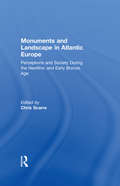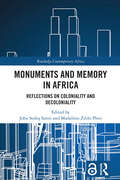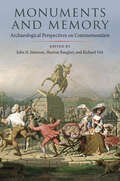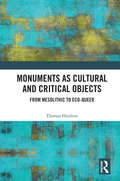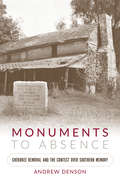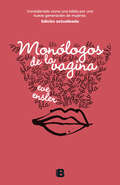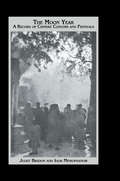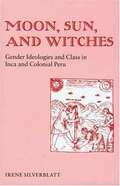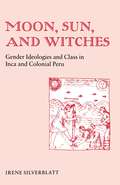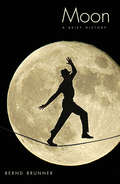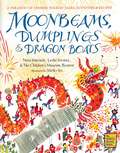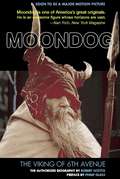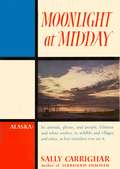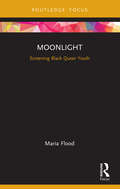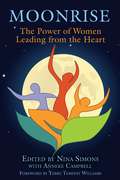- Table View
- List View
Monument Eternal: The Music of Alice Coltrane (Music Culture)
by Franya J. BerkmanLong-awaited biography of an African American avant-garde composer Alice Coltrane was a composer, improviser, guru, and widow of John Coltrane. Over the course of her musical life, she synthesized a wide range of musical genres including gospel, rhythm-and-blues, bebop, free jazz, Indian devotional song, and Western art music. Her childhood experiences playing for African-American congregations in Detroit, the ecstatic and avant-garde improvisations she performed on the bandstand with her husband John Coltrane, and her religious pilgrimages to India reveal themselves on more than twenty albums of original music for the Impulse and Warner Brothers labels. In the late 1970s Alice Coltrane became a swami, directing an alternative spiritual community in Southern California. Exploring her transformation from Alice McLeod, Detroit church pianist and bebopper, to guru Swami Turiya Sangitananda, Monument Eternal illuminates her music and, in turn, reveals the exceptional fluidity of American religious practices in the second half of the twentieth century. Most of all, this book celebrates the hybrid music of an exceptional, boundary-crossing African-American artist.
Monumental Ambivalence: The Politics of Heritage
by Lisa BregliaFrom ancient Maya cities in Mexico and Central America to the Taj Mahal in India, cultural heritage sites around the world are being drawn into the wave of privatization that has already swept through such economic sectors as telecommunications, transportation, and utilities. <P><P>As nation-states decide they can no longer afford to maintain cultural properties—or find it economically advantageous not to do so in the globalizing economy—private actors are stepping in to excavate, conserve, interpret, and represent archaeological and historical sites. But what are the ramifications when a multinational corporation, or even an indigenous village, owns a piece of national patrimony which holds cultural and perhaps sacred meaning for all the country's people, as well as for visitors from the rest of the world?
Monumental Conflicts: Twentieth-Century Wars and the Evolution of Public Memory
by Derek R. MallettMonumental Conflicts examines 20th century wars from the First World War to the First Gulf War, each chapter analyzing how public memory has evolved over time. The chapters raise fascinating questions about war and memory: Why are wars remembered as they are? What factors drive changes in public perception? What implications arise from remembering and commemorating a war or particular aspects of a war? What does public memory of a war say about us as a society? The volume is divided into three sections focusing on political evolution, negotiated memories of war, and national pride and covers international wars from Afghanistan to Vietnam and German deserter monuments to Vietnamese war tourism.
Monumental Controversies: Mount Rushmore, Four Presidents, and the Quest for National Unity
by Harriet F. SenieIn recent years the United States has witnessed major controversies surrounding past American presidents, monuments, and sites. Consider Mount Rushmore, which features the heads of the nation&’s most revered presidents—George Washington, Thomas Jefferson, Abraham Lincoln, and Theodore Roosevelt. Is Rushmore a proud national achievement or a symbol of the U.S. theft and desecration of the Lakota Sioux&’s sacred land? Is it fair to denigrate George Washington for having owned slaves and Thomas Jefferson for having had a relationship with Sally Hemings, an enslaved woman, to the point of dismissing these men&’s accomplishments? Should we retroactively hold Abraham Lincoln accountable for having signed off on the largest single-day mass execution in U.S. history, of thirty-eight Dakota men? How do we reckon with Theodore Roosevelt&’s legacy? He was criticized for his imperialist policies but praised for his prolabor antitrust and conservation programs. These charged issues and many others have been plaguing our nation and prompting the removal of Confederate statues and flags amid racial unrest, a national pandemic, and political strife. Noted art historian Harriet F. Senie tackles these pivotal subjects and more in Monumental Controversies. Senie places partisan politics aside as she investigates subjects that have not been adequately covered in classrooms or literature and require substantial reconciliation in order for Americans to come to terms with their history. She shines a spotlight on the complicated facts surrounding these figures, monuments, and sites, enabling us to revisit the flaws of our Founding Fathers and their checkered legacies while still recognizing their enormous importance and influence on the United States of America.Monumental Controversies presents strategies to create an inclusive narrative that honors the varied stakeholders in a democracy—a vital step toward healing the divisiveness that now appears to be a dominant feature of American discourse. As the public and press reconsider the viability of the American experiment in democracy, Senie offers a thoughtful reflection on the complex lives and legacies of the four presidents memorialized on Mount Rushmore. All four presidents faced some of the most contentious times in our history and yet they championed unity, made possible by acknowledging and accepting opposing opinions as a basic premise of democracy. Historians, curators, government officials, academics, and students at all levels will be riveted by this authoritative work.
Monumental Graffiti: Tracing Public Art and Resistance in the City
by Rafael SchacterWhat graffiti says about contemporary society, and why it demands our urgent attention as a form of civic expression.What is graffiti—vandalism, ornament, art? What if, rather than any of those things, we thought of graffiti as a monument? How would that change our understanding of graffiti, and, in turn, our understanding of monument? In Monumental Graffiti, curator and anthropologist Rafael Schacter focuses on the material, communicative, and contextual aspects of these two forms of material culture to provide a timely perspective on public art, citizenship, and the city today. He applies monument as a lens to understand graffiti and graffiti as a lens to comprehend monument, challenging us to consider what the appropriate monument for our contemporary world could be.Monumental Graffiti unpacks today&’s iconoclastic moment, showing us why graffiti demands our urgent attention as a form of expression that challenges power structures by questioning whose voices are included in—and whose are excluded from—public space. Written from twenty years of embedded research on graffiti, the book includes works from graffiti writers such as 10Foot, Delta, Egs, Honet, Mosa, Petro, Revok, and Wombat, alongside those of artists such as Francis Alÿs, Jeremy Deller, Thomas Hirschhorn, Jenny Holzer, Klara Liden, Gordon Matta-Clark, William Pope.L, Cy Twombly, and many more.Richly illustrated, this study of graffiti as monument and monument as graffiti is as fascinating as it is ethnographically expansive.
Monumental Lies: Culture Wars and the Truth about the Past
by Robert BevanHow statues, heritage and the built environment have become the battleground for the culture warsThe past is weaponised in culture wars and cynically edited by those who wish to impose their ideology upon the physical spaces around us. Holocaust deniers use details of the ruins of the gas chambers Auschwitz to promote their lies: &‘No Holes; No Holocaust&’. Yet long-standing concepts such as &‘authenticity&’in heritage are undermined and trivialised by gatekeepers such as UNESCO. At the same, time, opposition to this manipulation is being undermined by cultural ideas that prioritise memory and impressions over history and facts. In Monumental Lies, Robert Bevan argues that monuments, architecture and cities are material evidence of history. They are the physical trace of past events, of previous ways of thinking and of politics, economics and values that percolate through to today. When our cities are reshaped as fantasies about the past, when monuments tell lies about who deserves honour or are destroyed and the struggle for justice forgotten, the historical record is being manipulated. When decisions are based on misinformed assumptions about how the built environment influences our behaviour or we are told, falsely, that certain architectural styles are alien to our cities, or when space pretends to be public but is private, or that physical separation is natural, we are being manipulated. There is a growing threat to the material evidence of the truth about history.We are in serious trouble if we can no longer trust the tangible world around us to tell us the truth. Monumental Lies explores the threats to our understanding of the built environment and how it impacts on our lives, as well as offers solutions to how to combat the ideological manipulations.
Monumental Mobility: The Memory Work of Massasoit
by Jean M. O'Brien Lisa BleeInstalled at Plymouth, Massachusetts, in 1921 to commemorate the tercentenary of the landing of the Pilgrims, Cyrus Dallin's statue Massasoit was intended to memorialize the Pokanoket Massasoit (leader) as a welcoming diplomat and participant in the mythical first Thanksgiving. But after the statue's unveiling, Massasoit began to move and proliferate in ways one would not expect of generally stationary monuments tethered to place. The plaster model was donated to the artist's home state of Utah and prominently displayed in the state capitol; half a century later, it was caught up in a surprising case of fraud in the fine arts market. Versions of the statue now stand on Brigham Young University's campus; at an urban intersection in Kansas City, Missouri; and in countless homes around the world in the form of souvenir statuettes.As Lisa Blee and Jean M. O'Brien show in this thought-provoking book, the surprising story of this monumental statue reveals much about the process of creating, commodifying, and reinforcing the historical memory of Indigenous people. Dallin's statue, set alongside the historical memory of the actual Massasoit and his mythic collaboration with the Pilgrims, shows otherwise hidden dimensions of American memorial culture: an elasticity of historical imagination, a tight-knit relationship between consumption and commemoration, and the twin impulses to sanitize and grapple with the meaning of settler-colonialism.
Monumental Names: Archival Aesthetics and the Conjuration of History in Moscow (The Anthropology of History)
by Galina Oustinova-StjepanovicWhat stands behind the propensity to remember victims of mass atrocities by their personal names? Grounded in ethnographic and archival research with Last Address and Memorial, one of the oldest independent archives of Soviet political repressions in Moscow and a winner of the Nobel Peace Prize, the book examines a version of archival activism that is centred on various practices of documentation and commemoration of many dead victims of historical violence in Russia to understand what kind of historicity is produced when a single name is added to an endless list. What do acts of accumulation of names of the dead affirm when they are concretised in monuments and performance events? The key premise is that multimodal inscriptions of names of the dead entail a political, aesthetic and conceptual movement between singularity and multitude that honours each dead name yet conveys the scale of a mass atrocity without reducing it to a number. Drawing on anthropology, history, philosophy, and aesthetic theory, the book yields a new perspective on the politics of archival and historical justice while it critically engages with the debates on relations and distinctions between names and numbers of the dead, monumental art and its political effects, law and history, image and text, the specific one and the infinite many.
Monumentality in Later Prehistory: Building and Rebuilding Castell Henllys Hillfort
by Harold MytumThis volume provides the results of a 30-year excavation, reconstruction, and public interpretation campaign at the late prehistoric inland promontory settlement of Castell Henllys, here focusing on the defensive sequence and the role of monumentality in later prehistory. The site has international significance because of the extensive excavations of the Iron Age palisaded settlement and later earthen ramparts, complex gateway, and chevaux-de-frise of upright stones. It is now widely recognised that the Iron Age consisted of many regional cultural traditions, and the excavations at Castell Henllys provide a vital contrast to the well-known large hillfort communities in other parts of England and Wales as well as across Europe. As such, it is a unique window into a widespread but largely ignored site category and form of social and economic organisation. The publication will provide a case study for the construction and use of the earthworks of a major European late prehistoric settlement type - the Iron Age hillfort; the monumental construction is compared with other communal investments such as the Mississippian mounds. It will also offer an innovative form of site reporting, including alternative interpretations of the earthworks as either military defences or the community-binding symbols. Along with Excavation, Experiment, and Heritage Interpretation: Castell Henllys Hillfort Then and Now, these books will be required reading by those studying the late prehistoric archaeology of Britain and Europe at advanced undergraduate and postgraduate level, and by those in North America studying complex societies, monumentality, and ways of writing archaeology.
Monuments and Landscape in Atlantic Europe: Perception and Society During the Neolithic and Early Bronze Age
by Chris ScarreAtlantic Europe is the zone par excellence of megalithic monuments, which encompass a wide range of earthen and stone constructions from inpressive stone circles to modest chambered tombs. A single basic concept lies behind this volume - that the intrinsic qualities encountered within the diverse landscapes pf Atlantic Europe both informed the settings chosen for the monuments and played a role in determining their form and visual appearance. Monuments and Landscape in Atlantic Europe goes significantly beyond the limits of existing debate by inviting archaeologists from different countries with the Atlantic zone (including Britain, France, Ireland, Spain and Sweden) to examine the relationship between landscape features and prehistoric monuments in their specialist regions. By placing the issue within a broader regional and intellectual context, the authors illustrate the diversity of current archaeological ideas and approaches converging around this central theme.
Monuments and Memory in Africa: Reflections on Coloniality and Decoloniality (ISSN)
by John Sodiq Sanni Madalitso Zililo PhiriThis book investigates how monuments have been used in Africa as tools of oppression and dominance, from the colonial period up to the present day.The book asks what the decolonisation of historical monuments and geographies might entail and how this could contribute to the creation of a post-imperial world. In recent times, African movements to overthrow the symbols and monuments of the colonial era have gathered pace as a means of renaming, reclassifying, and reimagining colonial identities and spaces. Movements such as #RhodesMustFall in South Africa have sprung up around the world, connected by a history of Black life struggles, erasures, oppression, suppression, and the depression of Black biopolitics. This book provides an important multidisciplinary intervention in the discourse on monuments and memories, asking what they are, what they have been used to represent, and ultimately what they can reveal about past and present forms of pain and oppression.Drawing on insights from philosophy, historical sociology, politics, museum, and literary studies, this book will be of interest to a range of scholars with an interest in the decolonisation of global African history.
Monuments and Memory in Africa: Reflections on Coloniality and Decoloniality (Routledge Contemporary Africa)
by John Sodiq Sanni Madalitso Zililo PhiriThis book investigates how monuments have been used in Africa as tools of oppression and dominance, from the colonial period up to the present day. The book asks what the decolonisation of historical monuments and geographies might entail and how this could contribute to the creation of a post-imperial world. In recent times, African movements to overthrow the symbols and monuments of the colonial era have gathered pace as a means of renaming, reclassifying, and reimagining colonial identities and spaces. Movements such as #RhodesMustFall in South Africa have sprung up around the world, connected by a history of Black life struggles, erasures, oppression, suppression, and the depression of Black biopolitics. This book provides an important multidisciplinary intervention in the discourse on monuments and memories, asking what they are, what they have been used to represent, and ultimately what they can reveal about past and present forms of pain and oppression. Drawing on insights from philosophy, historical sociology, politics, museum, and literary studies, this book will be of interest to a range of scholars with an interest in the decolonisation of global African history.
Monuments and Memory: Archaeological Perspectives on Commemoration (Cultural Heritage Studies)
by Sherene Baugher John H. Jameson Richard VeitExamining the pasts, evolving meanings, and silenced histories surrounding public monuments This volume examines many different public monuments to increase understanding of the cultural factors that have shaped their creation, maintenance, and—in some cases—removal. The role of monuments in communities and society continues to be an important and controversial topic, and the case studies in this volume contribute to this conversation by assessing the ways such markers can be empowering or marginalizing from a wide range of perspectives. The monuments discussed here represent historical events from the Revolutionary War through the Korean War, including the “slave auction block” formerly located on the streets of Fredericksburg, Virginia; memorials to Confederate soldiers across the South and in northern POW cemeteries; and the Pullman National Monument in Chicago for workers who participated in the 1894 Pullman Strike. This volume also highlights the dearth of statues memorializing the achievements of women and minorities, especially women of color, and contributors discuss whether recent movements advocating for more inclusive histories will lead to an increase in monuments honoring people whose narratives have been suppressed. Looking at the powerful role of monuments in conveying the memory of history to future generations, the contributors to Monuments and Memory show why it is important to address the messages of these sites and ask whose histories they may be silencing. This book demonstrates how conversations surrounding preservation and interpretation of monuments encourage community involvement. A volume in the series Cultural Heritage Studies, edited by Katherine Hayes Contributors: Mark Cassello | Richard F. Veit | Mark Cianciosi | Joshua Butchko | Diane Wallman | Suzanne Spencer-Wood | Sherene Baugher | Lu Ann De Cunzo | John H. Jameson | Jeffrey Smith | Hilary Green | Brant Venables | Timo Ylimaunu | Paul R. Mullins | Kerri Barile | Harold Mytum | Melissa Ziobro | M. Jay Stottman | Levi Fox | Matthew Litteral
Monuments as Cultural and Critical Objects: From Mesolithic to Eco-queer
by Thomas HoultonMonuments as Cultural and Critical Objects explores monuments as political, psychical, social and mystical objects. Incorporating autoethnography, psychoanalysis, deconstruction, postcolonialism, and queer ecology, Houlton argues for a radical, interdisciplinary approach to our monument culture. Tracing historical developments in monuments alongside contemporary movements such as Rhodes Must Fall and Black Lives Matter, Houlton provides an in-depth critique of monument sites, as well as new critical and conceptual methodologies for thinking across the field. Alongside analysis of monuments to the Holocaust, colonial figures, and LGBTQIA+ subjects, this book provides new critical engagements with the work of D.W. Winnicott, Marion Milner, Jacques Derrida, Edward Said, Eve Sedgwick, and others. Houlton traces the potential for monuments to exert great influence over our sense of self, nation, community, sexuality, and place in the world. Exploring the psychic and physical spaces these objects occupy—their aesthetics, affects, politics, and powers—this book considers how monuments can challenge our identities, beliefs, and our very notions of remembrance. The interdisciplinary nature of Monuments as Cultural and Critical Objects means that it is ideally placed to intervene across several critical fields, particularly museum and heritage studies. It will also prove invaluable to those engaged in the study of monuments, psychoanalytic object relations, decolonization, queer ecology, radical death studies, and affect theory.
Monuments to Absence: Cherokee Removal and the Contest over Southern Memory
by Andrew DensonThe 1830s forced removal of Cherokees from their southeastern homeland became the most famous event in the Indian history of the American South, an episode taken to exemplify a broader experience of injustice suffered by Native peoples. In this book, Andrew Denson explores the public memory of Cherokee removal through an examination of memorials, historic sites, and tourist attractions dating from the early twentieth century to the present. White southerners, Denson argues, embraced the Trail of Tears as a story of Indian disappearance. Commemorating Cherokee removal affirmed white possession of southern places, while granting them the moral satisfaction of acknowledging past wrongs. During segregation and the struggle over black civil rights, removal memorials reinforced whites' authority to define the South's past and present. Cherokees, however, proved capable of repossessing the removal memory, using it for their own purposes during a time of crucial transformation in tribal politics and U.S. Indian policy. In considering these representations of removal, Denson brings commemoration of the Indian past into the broader discussion of race and memory in the South.
Monólogos de la vagina
by Eve EnslerConsiderado como una biblia por una nueva generación de mujeres, Los monólogos de la vagina es un libro agudo eirreverente. La obra maestra de Ensler que da voz a las fantasías y los temores más profundos del sexo femenino. «Me preocupan las vaginas. Me preocupaba lo que pensamos sobre las vaginas, y lo que no pensamos acerca de ellas... De modo que decidí hablar a las mujeres acerca de sus vaginas, entrevistar a la vagina, y así comenzaron los monólogos de la vagina. »Hablé con más de doscientas mujeres. Hablé con mujeres ancianas, con mujeres jóvenes, casadas, solteras, profesoras, actrices, profesionales, afroamericanas, hispanas, asiáticas, judías... Al principio se mostraban renuentes, un poco tímidas. Pero una vez que empezaban, no había modo de que parasen.»
Moon Year
by BredonFirst published in 2006. Routledge is an imprint of Taylor & Francis, an informa company.
Moon, Sun, And Witches: Gender Ideologies and Class in Inca and Colonial Peru
by Irene SilverblattState formation and gender hierarchy have been analyzed in this book with examples from real life situations.
Moon, Sun, and Witches: Gender Ideologies and Class in Inca and Colonial Peru
by Irene Marsha SilverblattWhen the Spanish arrived in Peru in 1532, men of the Inca Umpireworshipped the Sun as Father and their dead kings as ancestor heroes,while women venerated the Moon and her daughters, the Incaqueens, as founders of female dynasties. In the pre-Inca period suchnotions of parallel descent were expressions of complementarity betweenmen and women. Examining the interplay between gender ideologiesand political hierarchy, Irene Silverblatt shows how Inca rulersused their Sun and Moon traditions as methods of controllingwomen and the Andean peoples the Incas conquered. She then exploresthe process by which the Spaniards employed European maleand female imageries to establish their own rule in Peru and to makenew inroads on the power of native women, particularly poor peasantwomen.Harassed economically and abused sexually, Andean womenfought back, earning in the process the Spaniards' condemnation as"witches." Fresh from the European witch hunts that damnedwomen for susceptibility to heresy and diabolic influence, Spanishclerics were predisposed to charge politically disruptive poor womenwith witchcraft. Silverblatt shows that these very accusationsprovided women with an ideology of rebellion and a method fordefending their culture.
Moon: A Brief History
by Bernd BrunnerWerewolves and Wernher von Braun, Stonehenge and the sex lives of sea corals, aboriginal myths, and an Anglican bishop: In his new book, Moon, Bernd Brunner weaves variegated information into an enchanting glimpse of Earth's closest celestial neighbor, whose mere presence inspires us to wonder what might be "out there." Going beyond the discoveries of contemporary science, Brunner presents an unusual cultural assessment of our complex relationship with Earth's lifeless, rocky satellite. As well as offering an engaging perspective on such age-old questions as "What would Earth be like without the moon?" Brunner surveys the moon's mythical and religious significance and provokes existential soul-searching through a lunar lens, inquiring, "Forty years ago, the first man put his footprint on the moon. Will we continue to use it as the screen onto which we cast our hopes and fears?" Drawing on materials from different cultures and epochs, Brunner walks readers down a moonlit path illuminated by more than seventy-five vintage photographs and illustrations. From scientific discussions of the moon's origins and its "chronobiological" effects on the mating and feeding habits of animals to an illuminating interpretation of Bishop Francis Godwin's 1638 novelThe Man in the Moone, Brunner's ingenious and interdisciplinary explorations recast a familiar object in an entirely original and unforgettable light and will change the way we view the nighttime sky.
Moonbeams, Dumplings & Dragon Boats: A Treasury of Chinese Holiday Tales, Activities and Recipes
by Nina Simonds Leslie SwartzSpectacular fireworks, silk lions dancing through the streets, sumptuous family banquets--these are the hallmarks of Chinese New Year. Now, discover how to bring this splendid celebration, and others, into your own home. In this glorious collection, bestselling cookbook author Nina Simonds joins with Leslie Swartz and The Children's Museum, Boston, to offer festival lore, traditional stories, delectable recipes, and engaging activities that will inspire you to enjoy a full year of Chinese holidays. Try such treats as golden New Year's dumplings or tasty moon cakes. Build a kite at Qing Ming or a miniature dragon boat for the Dragon Boat Festival. Share the stories of the greedy Kitchen God or the valiant imperial warrior Hou Yi. Whether your family has embraced these holidays for generations or is introducing new traditions, Moonbeams, Dumplings & Dragon Boats offers exciting ways for the whole family to celebrate year after year.
Moondog
by Philip Glass Robert Scotto<P>The basis of a full-length documentary."Moondog is one of America's great originals."-Alan Rich, New York Magazine <P>Here is a revised edition of a book that celebrates one of the most improbable lives of the twentieth century: a blind and homeless man who became the most famous eccentric in New York and who, with enormous diligence, rose to prominence both in major label pop music recordings in addition to symphonic concerts of his compositions. <P>This edition of Moondog will soon be seen a as a feature documentary titled The Viking of 6th Avenue directed by Holly Elson and produced by Hard Working Movies.Born Louis Thomas Hardin in 1916, Moondog first made an impression in the late 1940s when he became a mascot of The New York Philharmonic at Carnegie Hall. His unique, melodic compositions were released on the Prestige jazz label. In the late 1960s the Viking-garbed Moondog was a pop music sensation on Columbia Records. <P>Moondog's compositional style influenced his former roommate Philip Glass, whose preface appears in the book. Moondog's work transcends labels and redefines the distinction between popular and high culture. <P>A wide-ranging compilation of Moondog recordings, which includes four Madrigals played by Philip Glass, Steven Reich, Jon Gibson, and Moondog himself, are offered as free downloads for every purchaser of this biography.
Moonlight At Midday
by Sally CarrigharThe author is an eloquent chronicler of wildlife. This book about Alaska (where she lived for 10 years) is more about people than animals. She distinguishes between two type of settlers, finding both to be openhearted and natural. Many fascinating photos of a time largely gone.
Moonlight: Screening Black Queer Youth (Cinema and Youth Cultures)
by Maria FloodThis book helps readers understand Moonlight’s profound political and social importance, the innovative technical choices adopted by director Barry Jenkins and the film’s adoption and disruption of traditional coming-of-age themes through the specific prism of Chiron’s childhood and youth. Moonlight (2016) is an intensely moving and poetically rendered coming-of-age story about a young gay Black boy, Chiron. Highly praised by both critics and audiences internationally, it garnered a surprise Best Picture win at the 2017 Academy Awards, enshrining its significance within a global cinematic canon. This book provides an account of how Moonlight can be situated in relation to African American youth films, contemporary queer cinema and its appeal to the youth market and representations of non-normative childhood and adolescence. It analyses the reception of Moonlight in terms of its form and profound emotional impact on spectators offerning new visions of African American boyhoods while also contributing an extended exploration of the social and political context of the film in relation to Obama, Trump and diversity in filmmaking. Highlighting to students and scholars the powerful emotional pull of Moonlight and why it is a highly significant film, this book is ideal for those interested in critical race studies, queer theory, youth cinema, African American cinema and LGBTQ cinema.
Moonrise: The Power of Women Leading from the Heart
by Terry Tempest Williams Nina Simons Anneke CampbellExplores the flourishing, passionate forms of leadership emerging from women on behalf of the earth and community • Contains more than 30 essays from successful women leaders, including writers Alice Walker and Eve Ensler, psychiatrist Jean Shinoda Bolen, holistic doctor Rachel Naomi Remen, hip-hop performer Rha Goddess, and famous tree-sitter Julia Butterfly Hill • From Bioneers president and cofounder Nina Simons Many today find themselves being called toward greater leadership on behalf of the Earth, toward leadership sourced from their inner authority and inspired by what they love and are dedicated to protect, transform, and strengthen. Those successfully heeding this call have embraced the qualities previously relegated to the “feminine”--inner awareness, collaboration, relational intelligence, respect for the sacred and generosity--and married them to the best of their “masculine” attributes to create a new form of leadership more inspiring, inviting, and effective for transforming how we live on Earth and with each other. This anthology presents more than 30 essays from eminent women trailblazers--such as author Alice Walker, psychiatrist Jean Shinoda Bolen, playwright Eve Ensler, holistic doctor Rachel Naomi Remen, biologist Janine Benyus, hip-hop performer Rha Goddess, and famous tree-sitter Julia Butterfly Hill--as well as lesser-known but equally influential leaders--such as social entrepreneur Judy Wicks, philanthropic activist Kathy LeMay, food justice advocate LaDonna Redmond, and media educator Sofia Quintero. Their narratives explore how they cultivated their leadership impulses and their “feminine” strengths, reinventing leadership to prioritize community, collaboration, the environment, and the common good. Illuminating a path to progressive environmental and social change, their passionate stories of joyful, creative, collaborative, and sacred leadership ignite within each reader the power to help cocreate a healthy, peaceful, just, and sustainable world.
